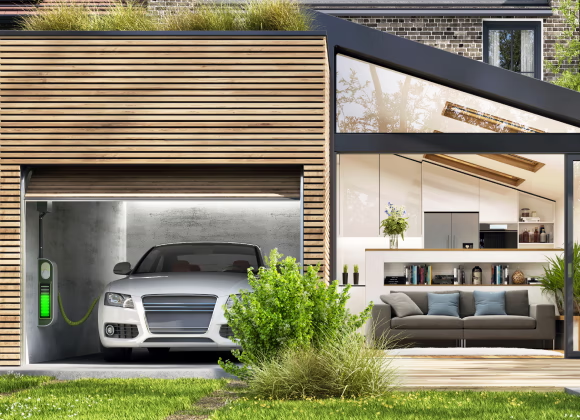All About Prefab Homes Australia
In the world of construction, there’s a term that’s been gaining momentum in Australia in recent years: prefab. Prefab is short for prefabrication and is an innovative but old-school construction method that has become as relevant now as ever. Prefab is being touted as one of the best solutions in the ever-growing housing concern across the country. Prefab currently holds just 5% of the $150 billion construction industry but is forecasted to gain 30% by 2033. In this article, we look at what prefab is, what are the reasons to consider building a prefab house, and all the essentials you need to know as a potential homeowner or owner-builder. What is Prefab? Prefab, short for prefabrication, is a type of construction that involves the manufacture of building components or entire structures in a factory setting before they are transported to the construction site for assembly. Think of it as constructing using pre-molded building blocks. These components can include wall panels, roof trusses, modules, or even entire rooms with fixtures already in place. Prefab allows construction to happen in a factory – any part of a building can be fabricated at a place other than the build site. Hence, it can also be termed as an off-site construction, off-site fabrication, or off-site manufacture. Prefab is akin to putting together a giant puzzle, with the ultra-precision of factory standards. How has prefab worked in Australia? First item-when was the first prefab house used in Australia? Answer …some were shipped here on the first fleet-I know as I have walked through the remaining ones that were restored in Victoria. The method first gained popularity in the post-war period, when there was a need to address the growing issues in housing supply, population growth, and labour shortage after the war. Prefab became the efficient and affordable answer to building homes. The common materials back then used concrete, steel, aluminum, and unfortunately, asbestos cladding. The brevity in design and conscious choice of affordable materials formed consumers’ notion that prefab meant utilitarian, cold, and hard. But nowadays, prefab has come a long way, far from mass-produced boxes. Customisable, better quality, and sustainable homes are what prefab dwellings provide – long gone are the utilitarian and plain structures decades ago. It only takes days (approximately 10-12 days) to build a typical prefab modular home. They are built indoors, which means it’s unaffected by poor weather conditions and can be completed much faster than a traditional build. In terms of having them fixed to site and services connect-well that depends on manufacturing style-if it was Volumetric (came on the back of a truck) or as a Kit of parts-or as a tilt up, or somewhere in between. Types of Prefab Homes Australia Here are two main types of prefab builds: Modular Homes This type of prefab is manufactured and constructed off-site to be assembled on the property. The components are modular, sectional, or volumetric three-dimensional units, meant to be portable and relocate even after construction. The beauty in modular homes is that individual modules can be joined to create larger spaces, and the entire structure can be customised to be a multi-level build should the design need it. These homes also come with electric fittings and water connections and are actually move-in ready once they are assembled on-site. Up front, modular homes are the most expensive type of prefab homes because they have the materials and structural units that resemble traditional home builds – of course with the advantage of being assembled faster in a factory setting. Kit Homes Kit homes also comprise of prefab components that are pre-cut, pre-sized, and pre-shaped, but the difference from modular homes is that a kit home arrives disassembled and would need to be put together by the owner or owens builder. These structures comprise of different ‘panels’ that form the building envelope, stair cores, load-bearing walls, and lighter partitions. Because the components and panels are in parts, kit homes are greatly customisable, with configuration options limited only by the homeowner’s imagination. Kit homes arrive much faster than modular homes, sometimes as little as a few weeks, but the caveat is that the owner will be in-charge of the installation on site. So, in some cases, even if you have the components ready, assembling them together might take longer. You’d want to hire a professional contractor who is well-versed in prefab installation. It is also important to consider that while kit homes are cheaper than modular builds, they do not always include electricity and water fittings. Adding these features will add costs to a kit home. Why Choose Prefab Homes? Prefab homes have several benefits that are relevant in the Australian housing sector: Speed. One of the key advantages of prefab housing is the speed of construction compared to traditional brick and mortar homes. While traditional construction can be hampered by weather delays, onsite mishaps, and tradies coordination, prefab components are manufactured in a controlled environment that eliminates the usual distruptions. Once on site, assembly may take days to weeks rather than months. Prefab expedites construction period significantly. Quality Assurance. Prefab components are manufactured to strict quality control standards. They aren’t subject to the variables that come with on-site construction. Structures are more likely to meet or exceed building codes and standards, reducing chances of rework. Factory precision also enables integration of advanced sustainable solutions before assembly. Safety. Health and safety are easier to control in a factory, where prefab elements are manufactured and sometimes assembled. Professionals can, for instance, work at waist height, and use machinery that can make tasks seamless. In contrast, traditional home construction has different variables (e.g., slippery floors, inclement weather, etc.) that could impact safety hazards. Sustainability. Australia, like much of the world, is moving towards sustainable practices. This applies to construction as well, and prefab is a great alternative that meets sustainable goals. It can potentially reduce waste, conserve energy, and optimise materials usage. As prefab is made in a controlled factory environment, there are precise measurements, fewer mistakes, and minimal excess in materials. Many prefab materials are also recyclable and are from sustainable sources. What About the Cost of Prefab Homes? While the uptake for prefab housing is still in its early stages, the manufacture and assembly are costlier than traditional build for residential homes. In fact, modular homes are about 15% to 50% pricier than traditional dwellings. Even though there are fewer labour trades involved and a more condensed construction period, there are still other expenses unique to prefab housing. For instance, the company may need to travel long distances to transport the modules or kit home to the site. This may add more fees or cause damage to the structure. Assembly may also rack up fees – builders use a crane or a helicopter in on-site work. Conclusion There is a considerable housing demand in the country, and as cities continue to grow, the construction and housing industry faces both opportunities and challenges. Prefab is an accessible solution, having been used for the last 20 years but far from maximized. No longer the cookie-cutter, post-war cheap housing box, prefab now features advanced designs, customisable modular spaces, and environmentally efficient solutions ready for Australia’s extreme conditions. It is still a more expensive option, but with renewed interest and support from the government, it may well be the answer to ramping up sustainable housing. Darin Hindmarsh See Full Bio

